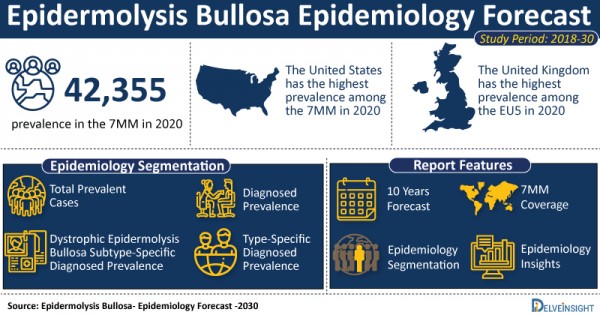
DelveInsight’s Epidermolysis Bullosa epidemiology forecast report provides a comprehensive understanding of Epidermolysis Bullosa, historical and forecasted epidemiology, as well as Epidermolysis Bullosa trends in the 7MM (the United States, EU5 (Germany, France, Italy, Spain, and the United Kingdom), and Japan).
Some of the Key Highlights from the Epidermolysis Bullosa Epidemiology Forecast Report
-
As per DelveInsight’s Epidermolysis Bullosa epidemiology insights, the total prevalent population was estimated to be 42,355 in the 7MM in 2020, where the total Epidermolysis Bullosa diagnosed prevalent cases were over 40,000 in the 7MM in 2020.
-
Among the 7MM, the estimates shows a higher Epidermolysis Bullosa prevalent as well as diagnosed cases in the United States with more than 25,000 cases respectively in 2020.
-
There are three major types of Epiermolysis Bullosa- Epidermolysis Bullosa Simplex (EBS), Junctional Epidermolysis Bullosa (JEB), and Dystrophic Epidermolysis Bullosa (DEB). Among these types of Epidermolysis Bullosa, the highest cases reported in the United States were of EBS followed by DEB and JEB in 2020.
-
Among the EU5 countries, the United Kingdom has the highest Epidermolysis Bullosa prevalent population while Spain had the lowest in 2020.
To know about the symptoms, diagnosis and treatment, request for sample @ Epidermolysis Bullosa Treatment
Epidermolysis Bullosa: Overview
Epidermolysis Bullosa (EB) is a group of skin diseases that cause skin and mucous membrane fragility to varying degrees. When essential proteins for skin integrity are missing, reduced, or abnormal, the skin becomes fragile. It is distinguished by the formation of blisters in response to mechanical trauma. Depending on the location of the target proteins and the severity of the blisters, there are four basic kinds of Epidermolysis Bullosa: Epidermolysis Bullosa simplex (epidermolytic), junctional Epidermolysis Bullosa (lucidolytic), dystrophic Epidermolysis Bullosa (dermolytic), and Kindler syndrome (mixed levels of blistering). Epidermolysis Bullosa can be autosomal dominant, autosomal recessive, or autosomal recessive.
Epidermolysis Bullosa Epidemiology Segmentation
The Epidermolysis Bullosa report proffers epidemiological analysis for the study period 2018-30 in the 7MM segmented into:
-
Epidermolysis Bullosa Total Prevalent Cases
-
Epidermolysis Bullosa Diagnosed Prevalence
-
Dystrophic Epidermolysis Bullosa Subtype-Specific Diagnosed Prevalence
-
Epidermolysis Bullosa Type-Specific Diagnosed Prevalence
Get a detailed analysis of epidemiology segmentation @ Epidermolysis Bullosas Epidemiology Forecast
|
1. |
Key Insights |
|
2. |
Executive Summary of Epidermolysis Bullosa (EB) |
|
3. |
Epidermolysis Bullosa (EB) Epidemiology Overview at a Glance |
|
4. |
Epidermolysis Bullosa (EB): Disease Background and Overview |
|
5. |
Epidermolysis Bullosav Patient Journey |
|
6. |
Epidermolysis Bullosa Epidemiology and Patient Population |
|
7. |
Country Wise-Epidemiology of Epidermolysis Bullosa |
|
8. |
Appendix |
|
9. |
DelveInsight Capabilities |
|
10. |
Disclaimer |
|
11. |
About DelveInsight |
For rich insights into Healthcare and Pharmaceutical News, visit Pharma, Healthcare and Biotech Blog Posts
Related Reports
Recessive Dystrophic Epidermolysis Epidemiology Forecast
DelveInsight’s ‘Recessive Dystrophic Epidermolysis–Epidemiology Forecast—2030’ report delivers an in-depth understanding of the historical and forecasted epidemiology Adult Myopia in the United States, EU5 (Germany, Spain, Italy, France, and the United Kingdom), and Japan.
About DelveInsight
DelveInsight is a leading Business Consultant and Market Research firm focused exclusively on life sciences. It supports Pharma companies by providing end to end comprehensive solutions to improve their performance.
Media Contact
Company Name: DelveInsight Business Research LLP
Contact Person: Sandeep Joshi
Email: Send Email
Phone: 9193216187
Address:304 S. Jones Blvd #2432
City: Las Vegas
State: NV
Country: United States
Website: www.delveinsight.com/

